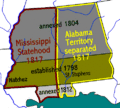History of Alabama facts for kids
The history of Alabama goes back thousands of years. Long ago, indigenous peoples lived there. From about 1000 BCE to 1000 CE, people in the Woodland period started farming. After that, the Mississippian culture thrived until around 1600 CE.
The first Europeans to visit Alabama were the Spanish. Later, the French built the first lasting European town, Mobile, in 1702.
Contents
Becoming a U.S. State
Alabama was part of the Mississippi Territory from 1798 to 1817. Then it became the Alabama Territory from 1817 to 1819. Finally, on December 14, 1819, Alabama became a U.S. state.
After this, many Native Americans were forcibly moved west of the Mississippi River. This area was called Indian Territory (now Oklahoma). Then, many European Americans moved into Alabama. Some of them brought or bought African Americans through the domestic slave trade.
The Civil War and Reconstruction
Wealthy farmers in Alabama believed that slavery was vital for their economy. Alabama had many enslaved people. Because of this, it was one of the first states to leave the United States. Alabama declared its secession in January 1861. It joined the Confederate States of America in February 1861.
During the American Civil War (1861–1865), Alabama saw some fighting. The state suffered economic losses and hardships. In 1863, President Lincoln's Emancipation Proclamation freed all enslaved people. The war ended in 1865, and the Confederate government in Alabama fell.
Alabama then entered the Reconstruction era (1865–1877). During this time, a government with both white and Black members was formed. They started the first public schools and welfare programs in the state.
Challenges and Changes After the War
For 50 years after the Civil War, Alabama was mostly poor and rural. Growing cotton was the main way people made money. Most farmers did not own land; they were tenants or sharecroppers.
Reconstruction ended when a group called "Redeemers" took back control. They were Democrats. They used both legal and illegal ways, including violence, to regain power. In 1901, Southern Democrats passed a new state Constitution. This law stopped most African Americans from voting. It also stopped tens of thousands of poor white people from voting. By 1941, over a million people had lost their right to vote.
In the early to mid-1900s, African Americans in Alabama faced many problems. They could not vote, schools were not funded equally, and they lived under segregation. They also faced violence. Many African Americans left Alabama during the Great Migration. They moved to cities in the North and Midwest for better jobs and opportunities. From 1900 to 1930, over 170,000 African Americans left the state. Because African Americans could not vote and rural white people controlled the government, Democrats ruled state politics. This was part of the "Solid South."
Modern Alabama
The Great Depression in the 1930s hit Alabama's economy hard. New government programs helped cotton prices rise, bringing some relief. During and after World War II, Alabama's economy grew. The state started to develop manufacturing and service industries. Cotton became less important as new machines reduced the need for farm workers.
After many years of struggle, important laws were passed. The Civil Rights Act of 1964 ended segregation. The Voting Rights Act of 1965 allowed African Americans to vote again.
In the mid to late 1900s, NASA built the Marshall Space Flight Center in Huntsville, Alabama. This helped Alabama's economy grow by creating an aerospace industry. In 1986, Guy Hunt was elected governor. This marked a change for Alabama. The state began to vote more for the Republican party in presidential elections. Voters also started to lean Republican in state elections. While Democrats still held many local offices, their complete control had ended.
In the early 21st century, Alabama's economy is strong. It is helped by aerospace, agriculture, car manufacturing, and the service industry.
Images for kids
-
Artists conception of Moundville, a Mississippian culture site on the Black Warrior River in Hale County
-
1725 map of Mobile, Alabama's first permanent European settlement
-
Mississippi Territory changes 1798–1817.
-
The inauguration of Jefferson Davis in Montgomery on February 18, 1861.
-
Blast furnaces such as the Tennessee Coal, Iron and Railroad Company's Ensley Works made Birmingham an important center for iron production in the early 20th century.
See also
 In Spanish: Historia de Alabama para niños
In Spanish: Historia de Alabama para niños










